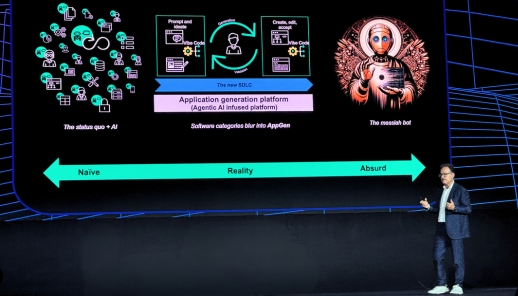Lo Giudice opened his keynote in Lisbon with a provocation: “AI unleashed will destroy the software industry.” A dramatic claim – but not a literal one. His message to CIOs and IT leaders was clear: the way we build and manage software is about to be rewritten.
The age of “co-pilots” is already giving way to a new paradigm – one where AI agents collaborate, plan, and execute across the software development lifecycle. The impact won’t just be on developers. It will reshape operating models, skill structures, and even the economics of software ownership. Here are 8 key takeaways for CIOs and IT Leaders.
1. Between hype and reality
Lo Giudice began by highlighting the two extremes. On one side, the “Messiah Bot” myth – a perfect AI that autonomously builds flawless software, eliminating the need for tools, platforms, or developers. On the other, the “Just a Copilot” illusion – treating generative AI as a simple assistant layered on top of old processes.
The future, he argues, lies in between. Agentic AI, where intelligent agents reason, plan, and collaborate with humans across every stage of software creation.
These “TuringBots,” as Forrester calls them, are no longer confined to coding. They are re-shaping requirements analysis, design, testing, delivery, and maintenance. In effect, AI is beginning to automate the relationships between the steps of software development, not just the steps themselves.
2. AI is compressing the software lifecycle
Traditional software development is linear and heavy with handoffs – from analysis to build, to test, to deploy. Agentic AI compresses that flow. A business requirement described in natural language can now trigger a cascade of autonomous actions:
– Generate user stories and acceptance criteria
– Write and validate code
– Create test cases and automation scripts
– Deploy and monitor results.
This isn’t theory – Lo Giudice estimates early adopters are already seeing 15–20% productivity gains, with potential to double by 2028 as agentic capabilities mature. The net effect? Software development is shifting from sequential to simultaneous, and from people-driven execution to AI-orchestrated collaboration.
3. Natural language won’t replace programming – models will
Can natural language become the new programming language? Lo Giudice says no – and this is where his message becomes critical for enterprise leaders. Human language is inherently ambiguous and imprecise. Enterprise software demands reliability, compliance, and performance – all of which require formal representation.
The bridge, he argues, is intermediate models – abstractions that sit between natural language and machine code. These include:
– Data models (to define structure and access)
– Process models (to encode logic and workflows)
– Low-code visual models (to represent user intent and behaviour)
This layer allows humans and AI to speak the same language – a precise, inspectable one. Low-code platforms are already proving this concept, acting as the canvas where intent becomes executable logic.
4. The rise of application generation platforms
The next evolution of low-code, Lo Giudice predicts, will be Application Generation Platforms – or AppGen. These platforms combine:
– Generative AI for ideation and code creation
– Agentic AI for orchestration across tools and workflows
– Model-driven environments for governance, compliance, and quality
AppGen platforms will deliver what enterprises have long wanted. Enterprise-grade automation with security, resilience, and scalability baked in. A unified authoring environment where natural language, vibe-coding (voice + visual), and models coexist. Plus, the ability to generate, validate, and deploy applications in hours – then observe and optimise them continuously. In short, AppGen is what happens when DevOps, low-code, and generative AI converge.
5. Redefining roles: from developers to platform teams
As AI takes over more of the build and test work, software development becomes a skill spectrum, not a single job.
– Business technologists and process owners will increasingly build or refine applications themselves, guided by intelligent agents.
– Platform engineering teams will own the infrastructure, governance, and AI orchestration that enable safe autonomy.
– Specialists will still exist – but as mentors, curators, and system architects within this hybrid ecosystem.
For CIOs, this demands a cultural shift: moving from resource management to capability orchestration. Your new asset isn’t code volume – it’s the speed at which intent becomes outcome.
6. Software as a continuum, not a product
One of Lo Giudice’s most provocative points: not all applications will “live” permanently. Some will be transient, generated and discarded on demand. Others will remain persistent, continuously regenerated as business rules evolve.
Why maintain and customise static software for years when AI can re-generate a compliant version in days? As one tech executive told him,
“If we keep doing what we do today, in five years our clients won’t buy our product anymore – they’ll buy whoever can generate it faster.”
The implication: AppGen capabilities will become a new buying criterion, not a nice-to-have.
7. What CIOs should do now
Savvy IT Leaders will take action now on numerous fronts:
– Experiment across the lifecycle: Don’t limit AI to coding assistance. Pilot use cases in requirements, testing, and deployment.
– Stand up a platform engineering function: Centralise governance, model libraries, and AI policy controls.
– Invest in model-driven design: Make process and data models mandatory inputs for AI.
– Build literacy at every level: Upskill business technologists and architects on agentic AI.
– Redefine success metrics: Measure time-to-value, not lines of code; business adaptability, not project completion.
8. The key takeaway
AI won’t “destroy” software – but it will force us to change the way we think about building it.
The future isn’t a “Messiah bot” that replaces us, nor a set of copilots that mimic us. It’s a network of collaborating agents and model-driven platforms that extend human creativity and compress time-to-impact.
For CIOs, the challenge is no longer whether AI will transform development – it’s whether your organisation, culture, and architecture can keep up.
In Lo Giudice’s words:
“Nobody wants to admit their own death is coming soon.”
But those who reinvent first won’t face death – they’ll define what comes next.

